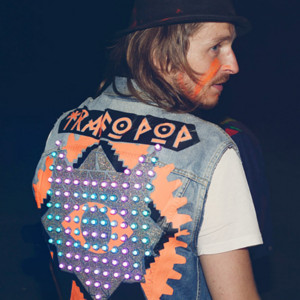
Photo: Florian Weningkamp / Stefan Hint
It’s already pretty dark in Berlin when Thomas Gnahm and his crew start pumping the pedals and lighting up the faces of surprised city dwellers with their glowing, flashing LED jackets. Now, he’s shifted his Trafo Pop bicycle gang into a higher gear: Wear it – Make Your Dress Code, the first festival celebrating Wearable Electronics and arts, happened October 11-12, 2014 in Berlin. Gnahm’s mission was to showcase the best of the wearable scene, found an international community and bring them together for speeches, workshops and parties. Nicole Grüneis of the Ars Electronica Center’s Education and Cultural Communication department met Thomas Gnahm, the founder of the Wear it Festival and the Trafo Pop bicycle gang, in conjunction with her research on future collaboration with Linz Art University’s new Fashion Design & Technology program.
How did you get interested in wearable electronics?
Thomas Gnahm: I’m a graphic designer and art director. So, I got together with some friends and we thought about doing something new and creative. Right from the start, we had this idea of forming a bicycle gang, and really making it something special. Then, finally, we thought up these LED jackets. But at that point, there wasn’t even the slightest talk of wearable electronics.
So, the idea preceded the light?
Thomas Gnahm: Exactly. Technology wasn’t our topic yet. We were focused on the concept of owning interesting jackets, and so the whole project is an outgrowth of that. Ultimately, we’ve constructed these jackets over the last year and a half to find out for ourselves what wearable electronics represent. We went deeper and deeper into the subject. And this year we organized the first Wear it Festival in Berlin.
The name of the bicycle gang is Trafo Pop…
Thomas Gnahm: OK, the word Trafo comes from transformer, a technical term meaning that electrical voltage is stepped from one level to another—in other words, energy transfer takes place. Plus, the word symbolizes precisely what we’re doing: with these jackets, we’re transforming ourselves into something new. We’re setting something in motion, and this motion ultimately also has something to do with cycling. We chose the word Pop because this has to do with something popular. This is not meant to be an elitist thing; we’re inviting everyone to join us and come along for the ride. With these illuminated jackets, we wanted to be part of popular culture. From the very inception, we designed this to be fun, that it’s fun for us to do and maybe a little kitschy. We wanted to play up the things that appeal to people, things they encounter in everyday life. We’re not in an interior space; we hit the streets.
The people around us become part of us. For me, that’s popular.
So, the reason why you’re lit up is that it’s visually very appealing and makes a big impact …
Thomas Gnahm: And you can design and experiment so much. What we were actually interested in is finding out all the things you can do with LEDs. It started with two little LEDs and took off from there. The question: can we design our jackets with LEDs and light in a way that’s totally new and surprises even ourselves?
How did you acquire the necessary technical knowhow?
Thomas Gnahm: The group grew quickly and we were joined by people who simply already know how it works. They taught us, and we, in turn, taught others. It’s an ongoing thing; the jackets are still being developed further. We’re fascinated by LED lights, but we’re also interested in how you can experiment with them. We like this sandbox feeling—when you can simply play around a little bit, build yourself a sandcastle, then take a shovel and pound it flat, and then take the sand and build something new. We want to experiment, and we see ourselves more as a lab than as a production facility.

Photo: Adlan Mansri
How often have you made public appearances as Trafo Pop?
Thomas Gnahm: For one thing, we stage our own events, riding through the city together at night every month or two. And every second or third month, we also hold one of our workshops where people can learn to build their own illuminated jackets. And then we make guest appearances at larger events—for instance, we were recently at the IFA consumer electronics trade show, where we also appeared in cooperation with private firms. Sometimes we’re invited to appear in Berlin clubs, where we get free admission and drinks, and we can do whatever we want. The great thing about it is that they expect us to come as we are, our real street look. This is exactly what we were looking for. That’s why it feels like being an artist—suddenly, everything you do is exactly right.
Speaking of art: during the Wear it Festival, there was never any mention of media art. Why do you think?
Thomas Gnahm: When you use the word “art,” then, right away, you’re on a level that’s slightly estranged from the object. It brings in a certain distance. Art always exists in the context of other art, or with history. Art is always assigned a location on a timeline, or placed in a social context. Art is supposed to have a message, give you something to think about. I find that the term “art” would also restrict us in a certain way. What we’re making could be art, it could be kitsch, but it could also be a utilitarian object. What we do is also humorous, self-mocking, and that’s also disarming. We can accept criticism, take it into account, and that simply helps us in the development process.
In my opinion, a piece of art somehow asserts the claim to being a finished work, and we see ourselves as having been engaged in a process the whole time. If you like, perhaps you could regard the entire action as art, by all means. The idea of creating a bicycle gang with these jackets, riding together on the street and offering workshops could be considered something like social art, as a movement that stimulates people on the street to think about it or to think differently. Then we fulfill all the criteria of art. But an individual jacket or the process of producing a jacket, now that I wouldn’t refer to as art.
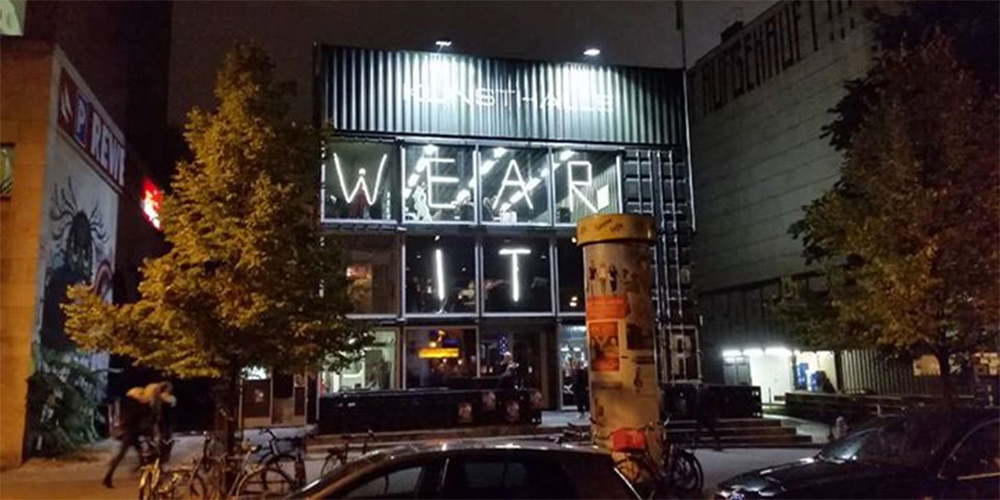
Photo: Adlan Mansri
What kind of people come to your workshops?
Thomas Gnahm: The people who came to the first workshops we staged were our friends and acquaintances. But then more and more people we didn’t know started to show up. There are about six openings at each workshop, so it’s always fully booked. These are people who are interested in technology, as well as ones who have absolutely no experience with it. In the beginning, we had a lot of professionals in the creative economy, people who worked at ad agencies or design studios. But, in the meantime, the word’s gotten out and we get people from all walks of life.
Do you feel that Berlin is the ideal setting for this? Would it work just as well at another location?
Thomas Gnahm: Yeah, just the other day we discussed whether we could introduce this concept into other cities—for example, Toronto or Philadelphia. I mean, we conceived the software as open source. I think that fashion, cycling, doing something in a group are all universal. You could even do this in China. It’s something that all people can relate to. And the exciting thing is: you can wear the results on your own body. This technology pertains to all of us.
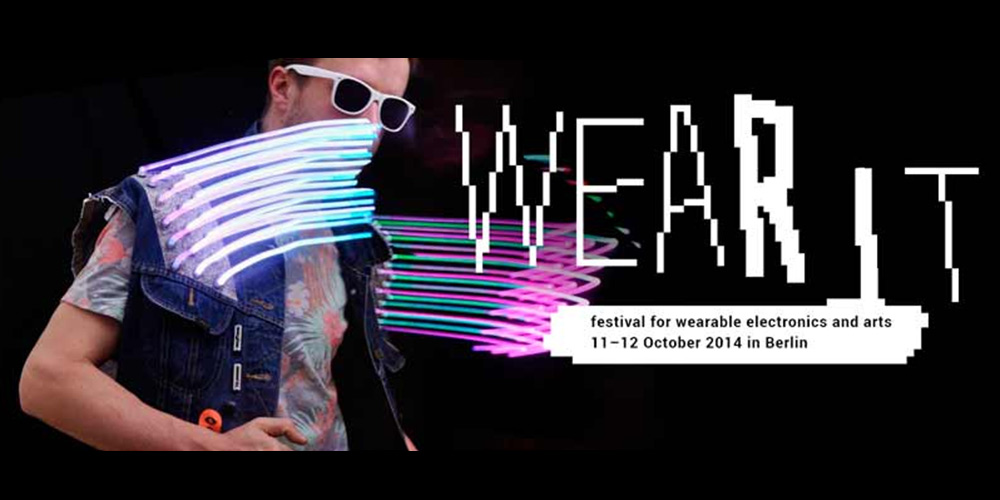
When did this spinoff a longing to launch Wear it, a festival specifically dedicated to this theme?
Thomas Gnahm: It wasn’t exactly a longing; we saw a need. We’re aware that there’s a fragmented scene all over the world. People are making amazing stuff, but everyone’s just doing his/her own thing. Sure, there are other meetings, etc. But what we want to accomplish is to bring together a selection of people we find interesting. And we also wanted to bring them to Berlin, to make it possible for the scene here to convene so people can get connected. It would simply be a shame if we didn’t make an effort to carry on this project.
How long did it take to organize Wear it? And what’s next?
Thomas Gnahm: It took about 3½ months to organize this. It was extremely labor-intensive, but we’re definitely looking forward to doing it again—annually, if possible. Soon, we’ll be getting started organizing the next festival. Of course, we’re seeking partners who can provide us with some support. It’s just fantastic that people can get together like this!
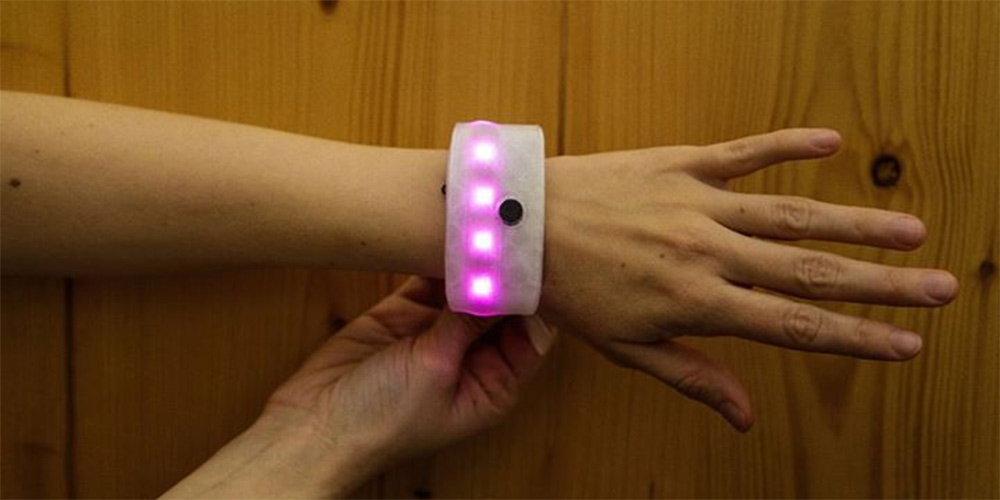
Photo: Adlan Mansri
Which wearables actually make sense for you as a private individual?
Thomas Gnahm: Well, in private life, I don’t even wear a wristwatch! Actually, because I have a tremendous affinity for technology, I try to refrain from inundating my private sphere with lots of high-tech paraphernalia. But I would use a very specific device—a bracelet that links me up with my girlfriend. It’s set up with a feature conceived for just the two of us, where I can make an adjustment and it changes the color of her bracelet. Something private, something emotional—I would wear that. What I’m much less interested in is a function that’s sort of general. My current pulse rate is of no great interest to me.
On the other hand, I have a smartphone that counts my paces and congratulates me after 10,000 steps—this actually has changed my behavior. What I’m looking for are interesting concepts, and they simply don’t exist yet. Some sort of smartwatch, despite lots of flashy features, is unable to fulfill my expectations. We now have the chance to custom-tailor the technology to ourselves instead of the other way around.
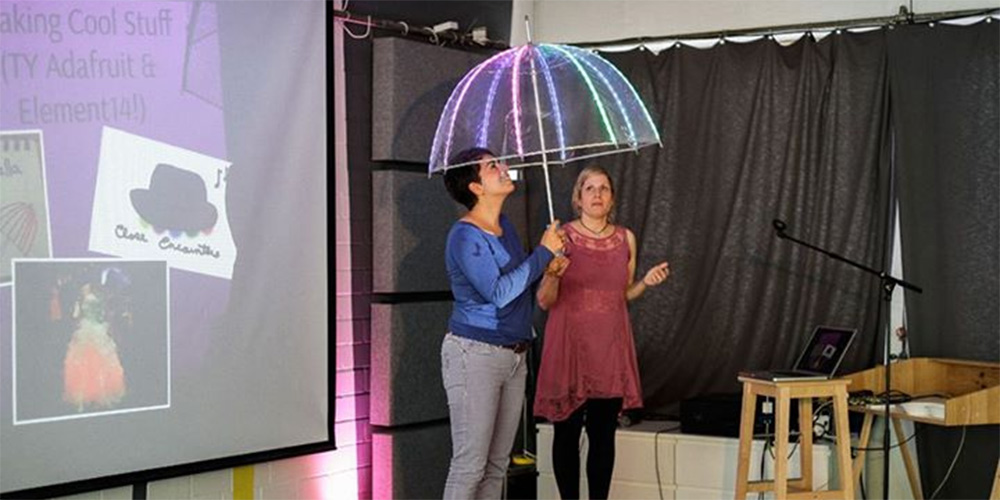
Photo: Adlan Mansri
Go into totally visionary thinking mode now: What wearable would you invent if you could? Sky’s the limit!
Thomas Gnahm: Then I’d like to have an article of clothing that’s totally universal, that can assume any form, any color and any condition, but the technology’s invisible. For instance, it looks like a normal shirt but it can morph into a glitter suit if I want. And maybe it also adapts to my current physical condition. If I’m warm, the thing gets cooler. It should be an object or a technology that knows my needs and preferences, and adjusts to me. There already exist interesting concepts in this area—for instance, something that Maartje Dijkstra exhibited at Wear it, a dress that can become transparent. The direction this is going in is the option to show more or less of oneself. The emotions I display as a person are translated verbatim.
Are you familiar with x.pose, a concept by Japanese designer Xuedi Chen? The longer she’s visible on social media platforms, the more transparent her corset becomes.
Thomas Gnahm: Yeah, sounds cool. Stuff like that interests me because they cast a new light on problematic situations or reveal facts and circumstances that we weren’t even aware of. These works illustrate this wonderfully. But the exciting thing about them is that the body behind them becomes visible. It’s not that the technology becomes increasingly visible. The more technology we use, the more the vulnerability of the human body reemerges. I find it fascinating that, in this case, it has to do with the human body.
Speaking of vulnerability—the Project Genesis exhibition at the Ars Electronica Center features “Chroma+Phy,” Theresia Schubert’s conception of an organic wearable. What’s your take on this?
Thomas Gnahm: I think it’s fascinating that your body’s current state can be measured and depicted, and you can be consciously aware of this. It’s too hot for me and the device shows that, but actually I’m not even conscious of the fact. And then I’d also like to find out for myself in which instance I sensed this on my own and when was it strictly the technology? And then I, in turn, can draw my own conclusions about what sort of mental state I’m in. For instance, am I under stress at the moment? I didn’t even notice that I’m dehydrated because I wasn’t paying attention—why; what distracted me? I think this is really fascinating because it tells me something about myself. Compare that to me checking out the current weather report displayed on my cell phone instead of just looking out the window… There are subtle differences. Here, the quality is in the details.
Hot Tip: If you want to know more about the current state of the art in digital fashion and find out what’s emerging on the horizon right now, don’t miss the speech by Christiane Luible, professor of fashion design, at Deep Space LIVE on Thursday, November 13, 2014 at 8 PM in the Ars Electronica Center!
